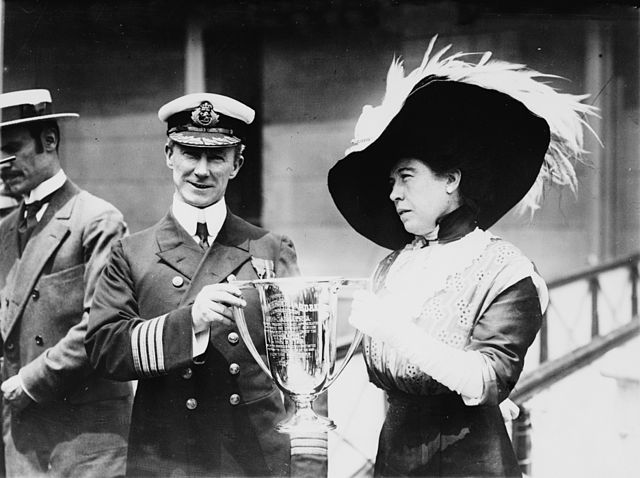“I’m Unsinkable”
Margaret Tobin Brown was reading a book in her first-class cabin on the Titanic when she heard a crash and was thrown to the floor by the impact. Pulling herself up, she went out into the corridor to investigate and saw her fellow passengers standing around in their nightwear. It was then she noticed that the engines had stopped. She went up on deck and was flung into a lifeboat with thirteen other people, three men and ten women. Amid the confusion and fear, Maggie promptly took command, organizing the other passengers of the small boat to row and buoying their spirits with her indomitable personality.
After her boat was picked up by the Carpathia shortly after dawn the next day, Maggie continued to help with rescue efforts. She later helped to form a committee of other wealthy survivors to help destitute victims of the disaster. Even before the Carpathia docked in New York, she had nearly $10,000 worth of pledges.
When she finally arrived in New York, she told a reporter that she attributed her survival to “typical Brown luck . . . We’re unsinkable.” Years later she was immortalized as “The Unsinkable Molly Brown” in Meredith Willson’s Broadway musical.
The daughter of Irish immigrants, Brown was born Margaret Tobin on July 18, 1867 in Hannibal, Missouri. She received little formal education and found work in her early teens as a waitress. Around 1884, she moved to Leadville, Colorado, after having purportedly been told by one of her customers, Samuel Clemens (Mark Twain), about the wealth that could be found in the Rockies. In Leadville, she met James Joseph (J.J.) Brown, the manager of a silver mine. The two married in 1886 and had two children, Helen and Lawrence.
J.J. made a small fortune in a gold find and he and Maggie moved to Denver. Maggie sought to enter Denver society but met with little success. After she and her husband separated, she began traveling throughout Europe with her son, Lawrence, where through her persistence and flamboyant personality she gained acceptance into the society of a group of wealthy Americans.
In 1912, she was touring Europe when she received word that her grandson, Lawrence Palmer, Jr., was ill. Brown immediately made arrangements to return to the States, booking her passage on the Titanic.
After the disaster, Brown used her money and newfound fame on behalf of a variety of causes, including women’s suffrage and local Catholic charities. She also led one of Denver’s first preservation projects when she spearheaded the movement to save the home of Denver poet, Eugene Field. She even ran for the U.S. Senate three times, failing to win each time. Brown’s declining years were spent traveling between Denver, New York and Newport, Rhode Island. At age 65, she suffered a stroke and died on October 26, 1932 at New York’s Barbizon Hotel.


Thanks for sharing!
Molly Brown was a remarkable woman whose generous spirit and great kindness will always be remembered.
she is very interesting she is my ancestor.
Molly brown is my famous missourian reasearck person at school she is a brave women. Its cool that she survived the Titanic.